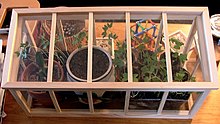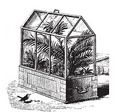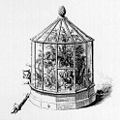Mini greenhouse
A mini greenhouse consists of a closed container with a translucent lid. The bottom tray is filled with soil, in which seedlings are then grown for later transplanting outdoors. Similar to a normal greenhouse , the principle is based on the greenhouse effect . Incident solar radiation warms the ground, warm air rises, but cannot escape. In order to avoid the risk of overheating in strong sunlight, the temperature of many products can be regulated via small windows in the lid.
Nutrient-poor soil is recommended for growing the seedlings. The seedling is forced to develop a good root system . The soil should be wet, but not in the water, otherwise the roots can rot. Avoid opening the lid frequently. Until the first leaf formation, the greenhouse should not be exposed to too high light intensity, otherwise the seedlings will grow too quickly without developing a strong stem .
The invention of the mini greenhouse is attributed to Nathaniel Bagshaw Ward around 1830.
Individual evidence
- ↑ Jane Tresidder, Stafford Cliff: Living under Glass. Fascinating glass houses, kindergartens and verandas from yesterday and today. Bauverlag, Wiesbaden and Berlin, 1986. ISBN 3-7625-2488-2 . P. 8
See also
literature
- Eva Schumann (author), Gerhard Milicka (author): The small greenhouse : technology and use ( hardcover ) . E. Ulmer Verlag, 1996, ISBN 3-8001-4290-2 .
- Nathaniel Bagshaw Ward: On the growth of plants in closely glazed cases. John Van Voorst, Paternoster Row, London, 2nd ed., 1852.
- Stephanie Hauschild (author), Melanie Wagner (author): Green under glass. Easy-care garden rooms , Ostefildern 2011.



